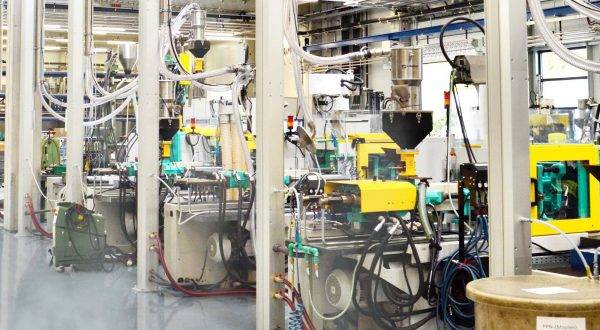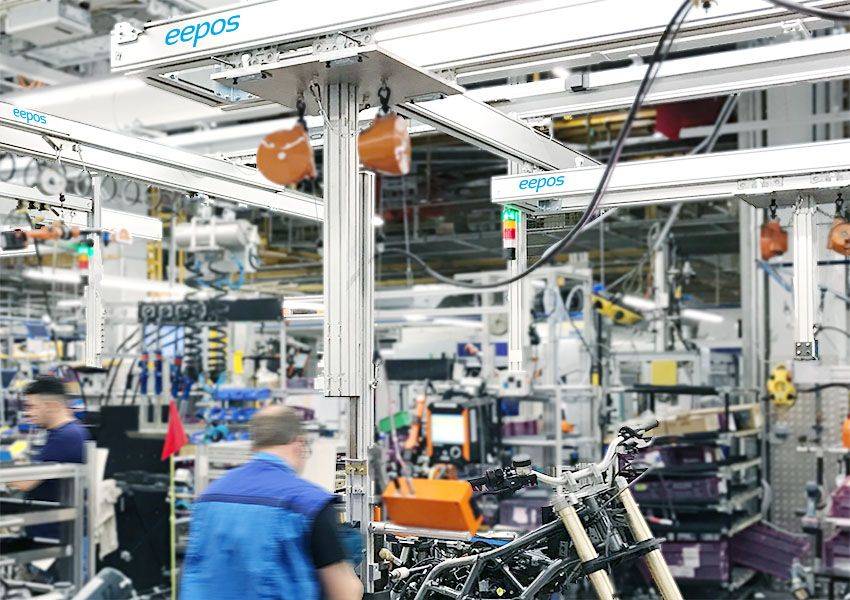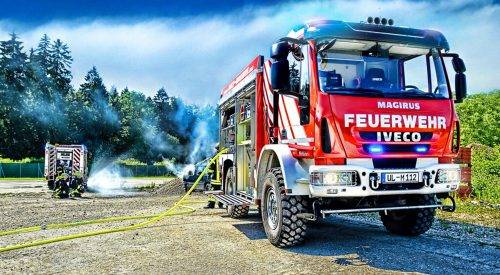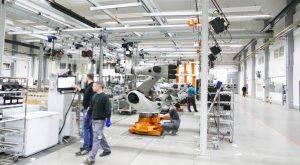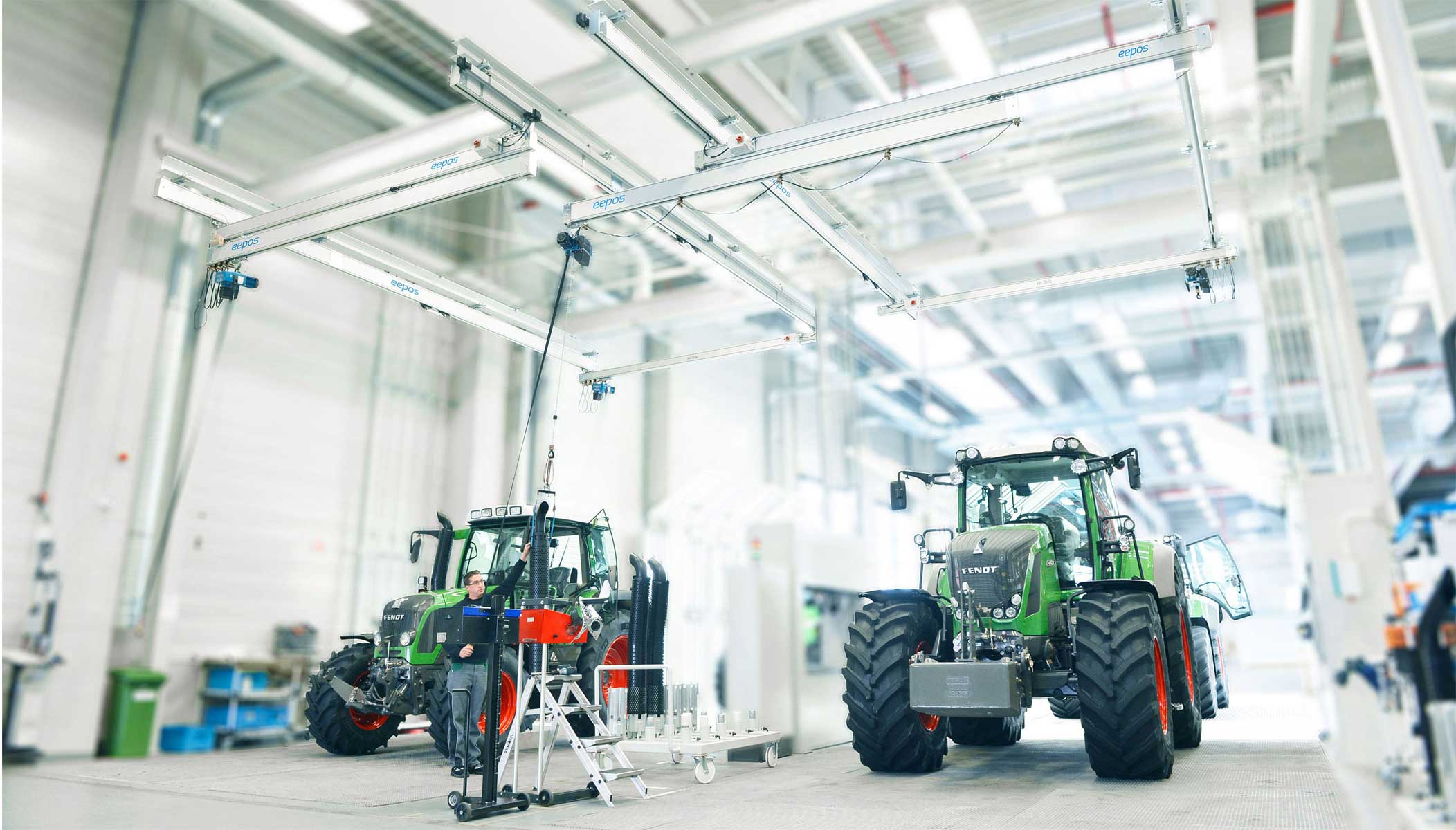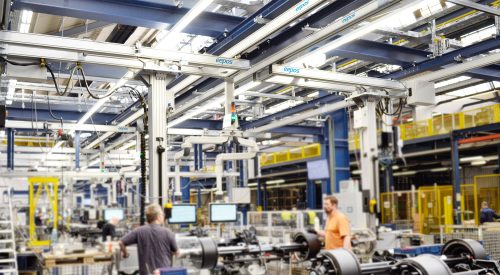The company BPW from Wiehl reduces the processing times of its products with the eepos crane systems and lifting axles and thus optimises the manufacturing and assembly processes. eepos asked the company about its experience with the eepos systems.
Quality must be on the road
To ensure the high quality for which BPW is known in the industry, the production facilities in Germany, Russia, Hungary, China, Australia and South Africa have uniform production and assembly systems for their chassis systems. They are all continuously improved with innovative assembly systems. When an optimization of the assembly processes was pending at the central location in Wiehl, Henrik Eyer, Head of Technical Services, dealt with the eepos aluminium crane systems. Since material feed, tool provision and quality controls at BPW take place at different stations, the use of crane systems and handling equipment has been a matter of course for decades. Marcus Walter from eepos, Henrik Eyer and Ralf Schneider, Technical Service, visited the systems on site and asked questions.
What is the reason why BPW chose eepos?
Eyer: The quality and technical features of the eepos aluminium crane systems convinced us. For this reason, we decided to use the eepos crane systems not only for axle assembly in our Wiehl plant, but also at our Hunsheim site, where we manufacture the brake systems for truck trailers and semi-trailers. In order for quality to reach the road, our production quality must be high.
So the focus was on the technical features?
Eyer: The technology must be right, but of course we are also interested in other aspects. We enjoy working with companies from the region. In the end, the competitive prices of eepos were added. All this has strengthened our decision in favour of the eepos systems.
And how did the eepos systems perform in practice?
Eyer: What pleases us is that the feedback from the employees on the new crane systems is consistently positive. We can therefore well imagine applying for eepos for future projects as well, and in fact we are already planning another plant together. The cooperation has so far worked well, from the planning stage through the entire input and support.
Was there something you liked right away?
Schneider: As a planner, I was convinced by both the smooth running without jamming, because it enables the required ergonomics and efficiency, and the provision of all necessary data via the online platform eeworld. This gives me access to further components from the modular system at any time and I can easily develop a wide variety of solutions myself.
What special features should the new crane systems have for assembly?
Schneider: For example, we have high demands on process reliability. In addition, there are high standards for ergonomics, assembly conditions as well as maintenance and testing work. Among other things, the five-year warranty on components spoke for eepos. Due to our complex assembly processes, however, system compatibility with our product range is particularly important to us. And finally, process reliability also means that the procurement of spare parts and further service support work. Here, regional proximity is another advantage.
Was there anything that was particularly important to you?
Schneider: Yes, we focused on two requirements. It is essential for us that the systems in our assembly are compatible with each other. As part of process optimization in assembly, we don’t want to have to deal with the interfaces between different systems every time. This is why we particularly like the eepos one service stations. On the other hand, one of our goals was to be able to implement the conversion quickly and flexibly. eepos was able to support us very well.
What exactly did that look like?
Schneider: With such extensive projects, good planning is of course a prerequisite. This enables us to respond flexibly and quickly to the requirements of our departments. eepos really supported us in this. Due to the friendly and helpful manner, the cooperation turned out to be very satisfactory. When the technical planning was finished, we carried out the construction of the plants independently. This is the best way for us to get to know our systems and to supplement, expand and optimise them at any time.
Have you achieved your goals?
Schneider: Yes, we were able to achieve all our goals within the set deadlines. And another thing: In addition to the advantages already mentioned, the eepos systems are extremely up-to-date and modern. This enables perfect integration of the eepos systems into BPW’s highly automated assembly processes. And the system makes daily work easier. Our employees will also confirm this to you. Moving weights of up to 80 kg is child’s play.
Süleyman Hür is working on the assembly line. He has been an assembler for many years and has passed through various work stations. He knows the assembly lines inside out.
What do you need the equipment for?
Hür: With the eepos systems, we mainly lift components such as hub groups in order to mount them on the axle. Sometimes they weigh 80 kg. With the crane, we can always position the components at the right height, so that they can then be assembled easily and without strain on the back.
And what do you think of the new aluminium cranes?
Hür: The systems are very easy to operate. We can move them back and forth as we need them without any great effort. (Sülyman Hür laughs). The smooth running of the system is great. Sometimes it’s almost too good. If the rails aren’t 100% aligned, the components sometimes move by themselves. That’s what we tell the service people, who take care of it.

